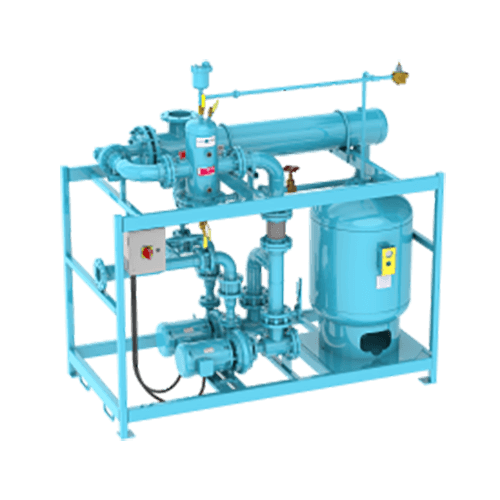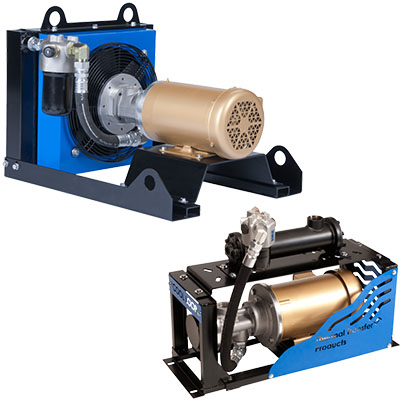A Comprehensive Overview to Selecting the Right Heat Transfer Equipments for Your Requirements
Selecting the proper Heat transfer system is essential for functional efficiency. Numerous systems accommodate various requirements, affected by elements such as temperature level variety and liquid type. Recognizing the principles behind Heat transfer, such as convection, radiation, and conduction, is important. Furthermore, evaluating energy resources and upkeep techniques can impact long-term efficiency. A closer examination of these factors to consider discloses just how to tailor a system to certain needs. What should one prioritize in this complicated decision-making process?
Comprehending Heat Transfer: Trick Ideas and Principles
Heat transfer may seem like a simple concept, it incorporates a range of principles that are basic for efficient system style - DVS Heat Transfer Systems. Recognizing these concepts is important for developers and designers that aim to maximize thermal efficiency in different applications. Conduction, as an example, entails the transfer of Heat via strong products, while convection describes the movement of Heat within fluids. Radiation, another crucial concept, describes how Heat can be transferred through electro-magnetic waves. Each of these mechanisms plays an important duty in identifying how energy moves within a system. By completely comprehending these ideas, specialists can make enlightened choices, making certain that Heat transfer systems run successfully and meet the certain needs of their applications
Kinds Of Heat Transfer Equipments: An Introduction
Understanding the concepts of Heat transfer prepares for checking out the various types of Heat transfer systems readily available. Heat transfer systems can be categorized largely into three types: radiation, convection, and transmission. Transmission involves Heat transfer via strong materials, counting on straight get in touch with in between bits. Convection, on the other hand, happens in fluids (liquids and gases) where the movement of the liquid itself assists in Heat transfer. Radiation includes the transfer of Heat via electro-magnetic waves and does not need a medium, enabling it to happen in a vacuum cleaner. Each kind of system has unique characteristics and applications, making it vital for people and companies to very carefully assess their particular needs when picking the most suitable Heat transfer solution.
Applications of Heat Transfer Systems in Numerous Industries
Heat transfer systems play a vital role across different industries, affecting effectiveness and item top quality. In industrial production processes, they help with specific temperature control, while in food and beverage processing, they assure safety and security and preservation. In addition, heating and cooling and climate control systems rely heavily on reliable Heat transfer to preserve comfortable settings.
Industrial Production Processes

Many industrial production processes count heavily on efficient Heat transfer systems to optimize performance and boost product high quality. In markets such as metalworking, Heat exchangers play a crucial role in preserving optimal temperatures during welding, casting, and creating. These systems ensure consistent Heat distribution, which is important for achieving desired material homes. In a similar way, in the chemical production industry, Heat transfer systems assist in exact temperature level control throughout reactions, influencing return and security. Furthermore, in textile manufacturing, effective Heat monitoring is important for coloring and completing procedures, affecting color consistency and fabric top quality. By selecting proper Heat transfer technologies, makers can enhance power effectiveness and decrease operational expenses, ultimately causing an extra competitive and sustainable production setting.
Food and Beverage Processing
Efficient Heat transfer systems are similarly vital in the food and beverage processing industry, where preserving excellent temperatures is essential for food safety and security and high quality. These systems play a crucial function in procedures such as pasteurization, food preparation, and sterilization, making certain that products are secure for intake and keep their dietary worth. Heat exchangers, as an example, efficiently transfer Heat between fluids, maximizing power use while reducing temperature level fluctuations. Additionally, refrigeration systems are essential for preserving perishable products and expanding life span. The choice of Heat transfer technology straight impacts functional performance and item stability, making it vital for food and drink producers to pick the appropriate systems tailored to their certain processing demands. This mindful choice ultimately adds to consumer satisfaction and food safety and security.

Cooling And Heating and Environment Control
While numerous markets count on Heat transfer systems for performance, A/C (Home Heating, Ventilation, and A/c) plays a vital function in maintaining interior environment control across various settings. These systems use Heat transfer principles to manage humidity, air, and temperature level high quality, making sure comfort and safety in residential, industrial, and industrial environments. Properly made cooling and heating systems enhance power performance, minimize functional expenses, and reduce environmental influence. In commercial buildings, as an example, efficient climate control adds to employee productivity and client contentment. In industrial applications, heating and cooling systems help keep excellent problems for tools operation and product preservation. Choosing the look at more info best Heat transfer system is essential for conference certain climate control requirements and achieving overall system performance.
Evaluating Energy Sources for Heat Transfer Solutions
In evaluating power resources for Heat transfer systems, a contrast of renewable energy options and nonrenewable fuel source considerations is crucial. Sustainable sources, such as solar and wind, deal sustainable options that can lower ecological effect. Alternatively, nonrenewable fuel sources continue to be common as a result of their established facilities and energy density, prompting a cautious assessment of both choices.
Renewable Power Options

Fossil Gas Factors To Consider
Reviewing fossil gas considerations is essential for the efficiency and sustainability of Heat transfer systems. Fossil fuels, such as all-natural gas, oil, and coal, are standard power resources that supply substantial Heat output, making them popular selections for property and industrial applications. Nonetheless, their environmental effect, consisting of greenhouse gas discharges and source deficiency, increases problems. When choosing a warm transfer system, it is crucial to analyze the schedule, price, and governing factors linked with these gas. In addition, the efficiency of fossil gas systems should be thought about, as greater efficiency can alleviate some environmental drawbacks. Inevitably, a well balanced technique considering efficiency and sustainability can lead decision-makers toward one of the most suitable Heat transfer remedy for their specific demands.
Variables to Take Into Consideration When Picking a Warm Transfer System
Selecting an ideal Heat transfer system calls for cautious consideration of various factors that can significantly affect efficiency and efficiency. One essential variable is the operating temperature array, which dictates the materials and style suitable for the application. Furthermore, the kind of fluid used in the system-- whether gas or fluid-- affects Heat transfer effectiveness and compatibility. The system's dimension and capacity must straighten with the particular demands of the procedure to prevent ineffectiveness. Power source availability is additionally important, influencing operating costs and sustainability. In addition, the installation environment, consisting of space restraints and accessibility for upkeep, plays a substantial function in system selection. Regulatory compliance and security requirements must be taken into consideration to assure the system fulfills all lawful demands.
Maintenance and Performance Optimization for Heat Transfer Systems
Preserving Heat transfer systems is vital for making sure maximum performance and longevity. Normal upkeep tasks, such as cleaning Heat exchangers and inspecting insulation, assistance protect against effectiveness losses due to fouling and thermal bridging. Additionally, keeping an eye on system criteria, consisting of pressure and temperature, permits early discovery of abnormalities, minimizing downtime and expensive repair work. Applying a precautionary maintenance routine can maximize efficiency and prolong the life expectancy of elements. Moreover, upgrading to sophisticated control systems can boost functional effectiveness by adapting to varying lots and problems. By prioritizing maintenance and performance optimization, drivers can attain lowered energy intake, lower operational prices, and improved general system reliability, inevitably leading to much better resource utilization and a more lasting operation.
Future Fads in Heat Transfer Technologies
As sectors significantly focus on sustainability and power effectiveness, future patterns in Heat transfer modern technologies are readied to undertake substantial makeovers. Developments such as innovative materials, including carbon nanotubes and nanofluids, guarantee enhanced thermal conductivity and performance. Furthermore, the assimilation of renewable resource sources into Heat transfer systems is obtaining energy, promoting environment-friendly services. Smart technologies, including IoT sensors, are expected to transform tracking and control, allowing real-time information evaluation for optimized performance. In addition, the development of small and modular systems will assist in less complicated setup and maintenance, accommodating varied applications. These innovations suggest a shift in the direction of even more sustainable, efficient, and adaptable Heat transfer solutions, straightening with worldwide energy objectives and look at here environmental criteria.
Frequently Asked Questions
What Are the Ecological Influences of Heat Transfer Solutions?
The environmental impacts of Heat transfer systems can consist of greenhouse gas exhausts, power intake, and potential thermal contamination. In addition, inappropriate disposal of ineffectiveness and materials can add to source exhaustion and environment disruption.
Exactly how Do I Calculate the Cost-Effectiveness of a Heat Transfer System?
To determine the cost-effectiveness of a warmth transfer system, one must evaluate preliminary prices, operational costs, maintenance demands, and power efficiency, comparing these aspects against the expected life-span and efficiency of the system.
Can Heat Transfer Systems Be Used in Residential Setups?
Heat transfer systems can undoubtedly be used in household settings. They give efficient home heating and cooling options, making homes a lot more comfy while potentially decreasing energy expenses. Their convenience allows for various applications in residential environments.
What Safety Regulations Apply to Heat Transfer Solutions?
Safety and security regulations for Heat transfer systems generally include standards on upkeep, setup, and procedure. Conformity with neighborhood building codes, maker requirements, and industry criteria is vital to guarantee secure and reliable system performance in numerous applications.
How Do Various Materials Affect Heat Transfer Performance?

Conduction, for circumstances, involves the transfer of Heat with solid materials, while convection refers to the motion of Heat within liquids. Comprehending the concepts of Heat transfer lays the foundation for discovering the numerous kinds of Heat transfer systems readily available. Heat exchangers, for instance, successfully move Heat in between liquids, enhancing energy usage while lessening temperature variations. In examining power sources for Heat transfer systems, a comparison of sustainable power choices and fossil gas considerations is necessary. Steels, such as copper and light weight aluminum, conduct Heat efficiently, whereas insulators like rubber and glass reduce down Heat circulation.